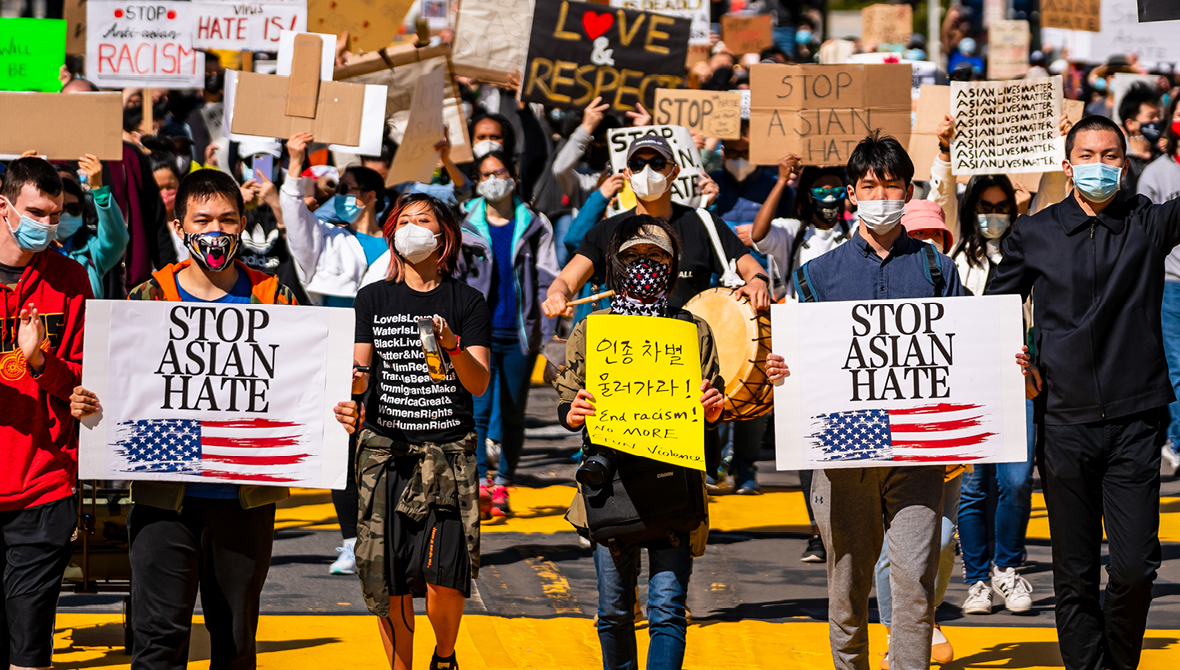AAPI Communities are Leading an Upswell in Philanthropy


 This article was first published in our 11 Trends in Philanthropy for 2024 report. Explore the full report here.
This article was first published in our 11 Trends in Philanthropy for 2024 report. Explore the full report here.
Want the latest trends, research, and more delivered right to your inbox? Subscribe to the Johnson Center email newsletter.
Asian American and Pacific Islander (AAPI*) communities are leading a shift in the philanthropic landscape. As demonstrated in the “Stop Asian Hate” movement or in response to the Maui wildfire’s devastating effects on local Lahaina communities, AAPI-led movements are mobilizing major resources.
Asian Americans “were the fastest-growing racial or ethnic group in the U.S. from 2000 to 2019” (Budiman & Ruiz, 2021, para. 1). In 2021, the estimated number of Asian American residents in the country was 24 million (U.S. Census Bureau, 2023). The 2020 election voter turnout rate for the non-Hispanic Asian population saw the largest jump (from 49% to 59%) of any identity group from 2016 to 2020 (Fabina, 2021).
Alongside this growth, however, stark patterns of inequality exist in parallel. In 2018, the Pew Research Center found that income inequality was the greatest among Asian Americans. Over an almost fifty-year period, the distribution of income “transformed from being one of the most equal to being the most unequal among America’s major racial and ethnic groups” (Kochhar & Cilluffo, para. 2).
“In 2021, more than 9,000 Asian business leaders and allies, including Zoom CEO Eric Yuan, YouTube cofounder Steve Chen, and OpenTable CEO Debby Soo, generated significant media attention when they pledged $10 million to partner with Asian Pacific Community Fund.”
Donors and foundations have historically neglected funding to address these challenges and more within AAPI communities. Asian Americans/Pacific Islanders in Philanthropy (AAPIP)’s 2021 report Seeking to Soar concludes that while the share of the U.S. population identifying as AAPI has more than doubled from 3% to 7% in 30 years, foundation funding for AAPI communities only accounted for 0.2% of domestic grantmaking, a “shocking disappointment” (p. 5). A survey by the Center for Effective Philanthropy further found that almost three-fourths (71%) of AAPI-serving nonprofits reported that they did not receive new foundation funding in 2020 (Buteau et al., 2021) even as xenophobic violence against AAPI communities increased 77% from 2019 to 2020 (Findling et al., 2022).
While there has long been advocacy by AAPI leaders and allies, recent calls to action in the face of violence have garnered increased momentum.
In 2019, Asian Americans Advancing Justice, made up of five of the country’s largest Asian American advocacy, policy, and legal service organizations, joined Communities Against Hate, a diverse coalition of 19 national organizations to fight rising violence. The Leadership Conference Education Fund, in partnership with Communities Against Hate (2019), released Hate Magnified: Communities in Crisis, a 2019 report analyzing almost 4,000 stories collected from the Communities Against Hate online database and a nationally representative Hate Incidence Poll. Many stories in the database involved anti-Asian and anti-immigrant rhetoric.
In March 2020, Stop AAPI Hate launched a website for individuals to safely share their experiences amidst a rise in COVID-related anti-Asian racism. In the following months, calls to “Stop Asian Hate” went viral in response to high-profile attacks, including the 2021 killing of 84-year-old Vicha Ratanapakdee in San Francisco and the series of 2021 Atlanta area spa shootings (Kai-Hwa Wong, 2022). Mutual aid groups — which have “long been a means for survival for many Asian American immigrants (Fernando, 2021, para. 16)” and whose networks swelled during the onset of the pandemic — responded broadly (Wang, 2021).
Key giving efforts to answer these calls have gained visibility and align with an array of existing philanthropic priorities, from donor-advised funds and giving circles to civic engagement and disaster response.
AAPI Data (2020) conducted surveys and interviews of AAPIP members and found “a steady increase of family foundations as well as AAPIs opening donor-advised funds with a focus on AAPI communities” (Ramakrishnan et al., p. 6). They also noted that a 2016 National Asian American Survey found that giving to charitable causes among Native Hawaiians and Pacific Islanders was among the highest.
According to AAPIP (n.d.), giving circles are a long-standing practice amongst AAPI communities. However, recent developments, such as $3.65 million in grants from the MacArthur Foundation (2023) (part of which helped fund The Chicago Community Trust’s Asian Giving Circle, 2023), The Denver Foundation’s (2023) establishment of a new affinity giving circle, and North Star Fund’s (2022) collaboration with Asian Women’s Giving Circle in New York City (reported as one of their top ten highlights from 2021), show the importance of this giving approach.
The AAPI Civic Engagement Fund, one of the largest funders of AAPI movement building, awarded $9 million in general operating grants over the past two years for civic participation (Jin Lee, 2023; Mesfin, 2022). In response to the Maui wildfires, NDN Collective (2023) encouraged Kanaka (Native Hawaiian)-led efforts, such as donations to the Hawai’i People’s Funds, the Nā `Aikāne o Maui Cultural Center, and the Maui Mutual Aid Fund.
In 2021, more than 9,000 Asian business leaders and allies, including Zoom CEO Eric Yuan, YouTube cofounder Steve Chen, and OpenTable CEO Debby Soo, generated significant media attention when they pledged $10 million to partner with Asian Pacific Community Fund (Stand with Asian Americans). Meanwhile, The Asian American Foundation (TAAF) reported commitments over five years totaling $1.1 billion in donations and in-kind support from more than 130 partners, leveraging significant support from AAPI business leaders (2023).
Beyond giving and grantmaking, significant cross-sector actions in service of AAPI communities are underway, such as President Biden’s creation of the President’s Advisory Commission on Asian Americans, Native Hawaiians, and Pacific Islanders (The White House, 2021); the debut of ASIAN AMERICANS, a major history documentary led by Asian American filmmakers lauded as “the most ambitious television chronicle of the Asian American story in the United States” (PBS, 2019, para. 1). NBC News compiled “100 of the ways legislators, teens, artists, schools, athletes and many others nationwide have stepped up to fight hate and increased attacks” (Yang et al., 2022, para. 1).
Additional historic public sector commitments in the past few years, such as $247 million in California and $30 million in New York state, have helped support nonprofits serving AAPI communities ranging in media outreach and social networking to a multilingual hate crime reporting hotline (Sohrabji, 2023; Coalition for Asian American Children and Families, 2023).
Going forward, AAPI Data and AAPIP’s latest report (2023), Stepping up for Community, suggest funders must:
Do the homework on understanding AA and NHPI nonprofits and the communities they serve. Support visibility of the experiences and concerns of AA and NHPI communities … especially under-invested and underserved populations … Invest in … smaller organizations … [and] Invest in the long-term capacity. (p. 3)
Maintaining progress hinges on listening — and amplifying the work and voice of AAPI communities leading by example.
The term “Asian American” has its roots in building people power during the 1960s and 1970s. While it continues to be used in this way, the term has also been critiqued for elevating some groups while obscuring others (Kaur, 2023, 2022). These different terms collectively refer to diverse groups of people with origins from more than 26 different nations, 50 ethnicities, and 100 languages (Findling et al., 2022; Banerjee, 2021; Kim, 2021).
The Pew Research Center notes the importance of self-description in how the U.S. Asian population talks about their identities (Ruiz et al., 2023; Ruiz et al., 2022), while ChangeLab (n.d.) describes how Asian American identity often comes with assumptions about this group as a monolith, and insists it must instead be understood within the broader contexts and systems of power that organize our society, including the social construction of race and our capitalist economic system. These themes and more affect how these terms have changed and will continue to shift over time.


AAPI. (2021, March). A call for solidarity and collective action. https://aapip.org/programs/a-call-for-solidarity-and-collective-action/
The Asian American Foundation. (2023). AAPI giving challenge. From the community, for the community. https://www.taaf.org/our-partners/giving-challenge
The AAPI Nonprofit Database. (2023). The Asian American Foundation. https://impactaapi.org/
AAPIP. (n.d.). National Giving Circle Network. https://aapip.org/programs/national-giving-circle-network/
Asian Americans Advancing Justice. (2019, January 16). Asian Americans are part of a diverse national coalition fighting hate violence. https://www.advancingjustice-aajc.org/news/asian-americans-are-part-diverse-national-coalition-fighting-hate-violence
Asian American Organizing Project. (2021, May 31). Ignite young Asian people power. https://aaopmn.org/2021/05/31/asian-heritage-month-whats-in-a-name/
Banerjee, A. (2022, June 7). Understanding economic disparities within the AAPI community. Economic Policy Institute. https://www.epi.org/blog/understanding-economic-disparities-within-the-aapi-community/
Budiman, A., & Ruiz, N. G. (2021, April 9). Asian Americans are the fastest-growing racial or ethnic group in the U.S. Pew Research Center. https://www.pewresearch.org/short-reads/2021/04/09/asian-americans-are-the-fastest-growing-racial-or-ethnic-group-in-the-u-s/
Buteau, E., Malmgren, K., & Martin, H. (2021). Overlooked (part 1): Foundation support for Asian American and Pacific Islander leaders and communities. Center for Effective Philanthropy. https://cep.org/wp-content/uploads/2021/07/CEP_Overlooked_AAPI.pdf
ChangeLab. (2023). A Different Asian American Timeline. AA Timeline. https://aatimeline.com/
The Chicago Community Trust. (2023, May 19). AAPI heritage month spotlight: Asian giving circle. https://www.cct.org/stories/aapi-heritage-month-spotlight-asian-giving-circle/
Choi, F. (2017, August 17). Asian Americans are part of a diverse national coalition fighting hate violence. Hyphen. https://hyphenmagazine.com/blog/2017/08/asian-americans-are-part-diverse-national-coalition-fighting-hate-violence
Coalition for Asian American Children and Families. (2023, May 26). Equity Budget Coalition celebrates New York State’s $30 million investment in AAPI communities. https://www.cacf.org/resources/ebc-celebrates-aapi-equity-budget-2023
Communities Against Hate. (2019, January). Hate magnified: Communities in crisis. https://hatemagnified.org/CAH-hatemagnified2019.pdf
Daniels, A. (2021, March 26). Nearly 500 foundation leaders united to push for more support of Asian Americans. The Chronicle of Philanthropy. https://www.philanthropy.com/article/hundreds-of-foundation-leaders-unite-to-push-for-more-support-of-asian-americans
The Denver Foundation. (2023, May 4). The Asian-American & Pacific Islander giving circle turns one! https://denverfoundation.org/2023/05/the-asian-american-pacific-islander-giving-circle-turns-one/
Fabina, J. (2021, April 29). Record high turnout in 2020 general election. U.S. Census Bureau. https://www.census.gov/library/stories/2021/04/record-high-turnout-in-2020-general-election.html
Findling, M. G., Blendon, R. J., Benson, J., & Koh, H. (2022, April 12). COVID-19 has driven racism and violence against Asian Americans: Perspectives from 12 national polls. Health Affairs. https://www.healthaffairs.org/content/forefront/covid-19-has-driven-racism-and-violence-against-asian-americans-perspectives-12
Ford, L., Arabandi, B., Lou, C., Wong, J., Ong, A., Sankofa, J., & Lei, S. (2021, July). Advancing equity for AAPI communities. Urban Institute. https://www.urban.org/sites/default/files/publication/104527/advancing-equity-for-aapi-communities_0.pdf
Iwasaki Milbauer, S. (2021, May 31). Asian Heritage Month: What’s in a Name? Asian American Organizing Project (AAOP). https://aaopmn.org/2021/05/31/asian-heritage-month-whats-in-a-name/
Jin Lee, K. (2023, May 9). AAPI Civic Engagement Fund awards $5.4 million in 2023 to bolster AAPI civic participation and strengthen multi-racial democracy in the U.S. AAPI Civic Engagement Fund. https://aapifund.org/news/press-release-20230509/
Kai-Hwa Wang, F. (2022, April 11). How violence against Asian Americans has grown and how to stop it, according to activists. PBS. https://www.pbs.org/newshour/nation/a-year-after-atlanta-and-indianapolis-shootings-targeting-asian-americans-activists-say-we-cant-lose-momentum
Kan, L.M. (2021, March). Seeking to Soar: Foundation funding for Asian American & Pacific Islander communities. Asian Americans/Pacific Islanders in Philanthropy. https://aapip.org/wp-content/uploads/2021/07/seeking_to_soar_foundation_funding_for_aapi_communities_1.pdf
Kaur, H. (2022, May 4). The term “Asian American” has a radical history. CNN. https://www.cnn.com/2022/05/04/us/history-of-term-asian-american-cec/index.html
Kaur, H. (2023, May 1). Why some have mixed feelings about the terms Asian American and AAPI. CNN. https://www.cnn.com/2023/05/01/us/asian-american-aapi-terms-history-cec/index.html
Kim, B. (2021, August 3). Low-income Asian Americans and Pacific Islanders remain invisible as pandemic protections expire. Dorothy A. Johnson Center for Philanthropy. https://johnsoncenter.org/blog/low-income-asian-americans-and-pacific-islanders-remain-invisible-as-pandemic-protections-expire/
Kochhar, R., & Cilluffo, A. (2018, July 12). Income inequality in the U.S. is rising most rapidly among Asians. Pew Research Center. https://www.pewresearch.org/social-trends/2018/07/12/income-inequality-in-the-u-s-is-rising-most-rapidly-among-asians/
Lo, F., Ramakrishnan, K., Tan, C., Gasaiwai, P., Eng, P., & Hadi, B. (2023). Stepping up for community amidst COVID-19, xenophobia and violence: A survey of nonprofits serving Asian-American, Native Hawaiians, and Pacific Islanders. AAPI Data and AAPIP. https://aapidata.com/wp-content/uploads/2023/06/SteppingUp-2023-web.pdf
MacArthur Foundation. (2023, February 2). Upholding Chicago’s Asian American Pacific Islander communities. https://www.macfound.org/press/grantee-news/upholding-chicago%E2%80%99s-asian-american-pacific-islander-communities
Mesfin, B. (2022, July 26). AAPI Civic Engagement Fund awards $3.6 million in general operating support to movement building groups across the country. AAPI Civic Engagement Fund.
https://aapifund.org/news/press-release-20220726/
National Giving Circle Network. (2023, September 16) Asian Americans/Pacific Islanders in Philanthropy. https://aapip.org/programs/national-giving-circle-network/
NDN Collective. (2023, August 16). NDN releases statement on Maui wildfire tragedy, urges Native Hawaiian-led solutions. https://ndncollective.org/ndn-collective-releases-statement-on-maui-wildfire-tragedy-urges-native-hawaiian-led-solutions/
North Star Fund. (2022, January 25). Top ten North Star Fund highlights from 2021. https://northstarfund.org/2022/01/top-ten-north-star-fund-highlights-from-2021/
PBS. (2019, July 29). PBS and WETA announce groundbreaking documentary series ASIAN AMERICANS. https://www.pbs.org/about/about-pbs/blogs/news/pbs-and-weta-announce-groundbreaking-documentary-series-asian-americans/
Pew Research Center. (2020, February 6). What census calls us. https://www.pewresearch.org/interactives/what-census-calls-us/
Pratt, B. M., Hixson, L., & Jones, N. A. (2015, September 4). Measuring race and ethnicity across the decades, 1790-2010. U.S. Census Bureau. https://www.census.gov/data-tools/demo/race/MREAD_1790_2010.html
Ramakrishnan, K., Do, M., & Shao, S. (2020, September). State of philanthropy among Asian Americans and Pacific Islanders: Findings and recommendations to strengthen visibility and impact. AAPI Data. https://aapidata.com/wp-content/uploads/2020/09/aapi-state-of-philanthropy-2020-report.pdf
Ruiz, N. G., Noe-Bustamante, L., & Shah, S. (2023, May 8). Diverse cultures and shared experiences shape Asian American identities. Pew Research Center. https://www.pewresearch.org/race-ethnicity/2023/05/08/diverse-cultures-and-shared-experiences-shape-asian-american-identities/
Ruiz, N. G., Shao, S., & Shah, S. (2022, August 2). What it means to be Asian in America. Pew Research Center. https://www.pewresearch.org/race-ethnicity/2022/08/02/what-it-means-to-be-asian-in-america/
Sohrabji, S. (2023, September 11). API Equity Budget in jeopardy as California faces $20 billion deficit. Ethnic Media Services. https://ethnicmediaservices.org/stop-the-hate/api-equity-budget-in-jeopardy-as-california-faces-20-billion-deficit/
Stand with Asian Americans. (2021, March 31). Enough. An open letter from Asian American business leaders. https://standwithasianamericans.com/wp-content/uploads/2023/01/swaa-wsj-pledge.pdf
Stop AAPI Hate. (n.d.). Our origins. https://stopaapihate.org/our-origins/
U.S. Census Bureau. (2018, January 23). About the topic of race. https://www.census.gov/topics/population/race/about.html
U.S. Census Bureau. (2023, March 3). Asian American, Native Hawaiian and Pacific Islander Heritage Month: May 2023.
https://www.census.gov/newsroom/facts-for-features/2023/asian-american-pacific-islander.html
Wang, C. (2021, February 19). Multiracial mutual aid efforts help Chinatown senior citizens, Asian American communities. NBC News. https://www.nbcnews.com/news/asian-america/multiracial-mutual-aid-efforts-help-chinatown-senior-citizens-asian-american-n1258356
The White House. (2021, December 20). President Biden announces intent to appoint commissioners to the President’s Advisory Commission on Asian Americans, Native Hawaiians, and Pacific Islanders. https://www.whitehouse.gov/briefing-room/statements-releases/2021/12/20/president-biden-announces-intent-to-appoint-commissioners-to-the-presidents-advisory-commission-on-asian-americans-native-hawaiians-and-pacific-islanders/
Yang, A., Yam, K., Wang, C., & Kaur, B. (2022, May 2). AAPI Action: 100 ways Asian Americans and allies are fighting hate crimes, violence. NBC News. https://www.nbcnews.com/specials/asian-americans-pacific-islanders-allies-fighting-hate/index.html